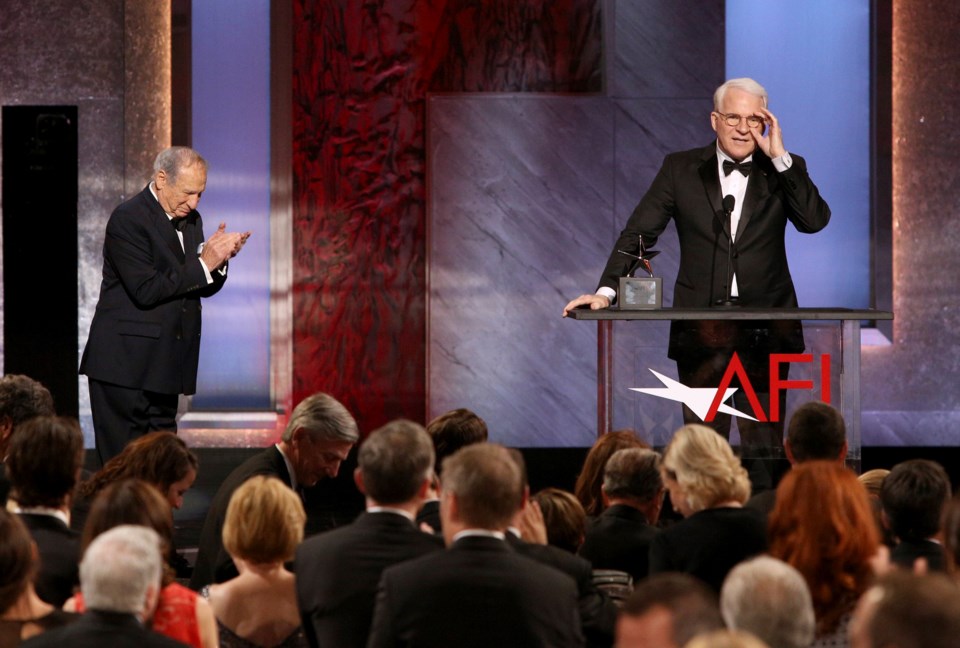NEW YORK (AP) ā Steve Martin has long marveled at the many phases of his life. Thereās his youth as a Disneyland performer, surrounded by vaudeville performers and magicians. A decade as a stand-up before the sudden onset of stadium-sized popularity. An abrupt shift to movies. Later, a new chapter as a banjo player, a father and, a comedy act, .
Itās such a confounding string of chapters that Martin has typically only approached his life piecemeal or schizophrenically. He titled an audiobook His memoir, covered only his stand-up years. In it, he wrote that it was really a biography ābecause I am writing about someone I used to know.ā
āMy life has many octopus arms,ā Martin says, speaking from his New York apartment.
People participate in documentaries for all kinds of reasons. But Martin may be unique in making a film about his life with the instruction of: āSee if you can make sense of all THAT.ā Morgan Neville, the documentary filmmaker of āWonāt You Be My Neighborā and took up the challenge.
Yet Neville, too, was hesitant about any holistic view of Martin. The resulting film is really two. premiering Friday on Apple TV+, splits Martinās story in two halves. One depicts Martinās stand-up as it unfolded, with copious contributions from journal entries and old photographs. The other captures Martinās life as it is today ā riding electric bikes with Short, practicing the banjo ā with reflections on the career that followed.
Itās an attempt to synthesize all the Steve Martins, or at least line them up next to each other. The āKing Tutā guy with the arrow through his head. The āwild and crazy guy.ā The āJerk.ā The Grammy-winner. The novel writer. And the self-lacerating comic who says in the film: āI guarantee I had no talent. None.ā
āJust because you do a lot of things doesnāt mean theyāre good,ā Martin says. I know that time evaluates things. So thereās nothing for me to stand on to evaluate my efforts. But an outsider can make sense of it.ā
Neville, who joined the video call from his home in Pasadena, California, didnāt set out to make two films about Martin. But six months into the process, it crystalized for him as the right structure. Through lines emerged.
āWhen I look at the things Steveās done in his life ā playing banjo, magic, stand-up ā these are things that take great effort to master,ā Neville says. āBut in a way, itās the constant working at it. Even seeing Steve pick up a banjo, itās never, āI nailed it.ā Itās always: āI could do that a little better.āā
Looking back hasnāt come naturally to Martin. Heās long resisted the kind of life-story treatment of a film like āSTEVE!ā But Martin, 78, grants heās now at that time of life where you canāt help it. Even if reliving some things smarts.
āThe first part, thatās what I really have a hard time watching,ā Martin says. āWhen Iām on black-and-white homemade video being so not funny.ā
Martin grew up in Orange County in awe of Jerry Lewis, Laurel and Hardy and Nichols and May. His first job, as an 11-year-old, was selling guide books at Disneyland. He drifted toward the Main Street Magic Shop. Stage performers like Wally Boag became his idols.
When Martin, after studying philosophy in college and writing for āThe Smothers Brothers Comedy Hour,ā began stand-up, he drew copiously from Boag and others, filtering the showmanship of vaudeville into an avantgarde act, just with balloon animals and an arrow through his head. Donning the persona of, as he says in the film, āa comedian who thinks heās funny but isnāt,ā his routine moved away from punchlines and toward an absurd irony with āfree-form laughter.ā
Martinās act was groundbreaking and, in the 1970s, when most comics were doing political material, it became wildly popular. āHeās up there with the most idolized comedians ever,ā Jerry Seinfeld says in the film. Now, Martin doesnāt see much from those years that makes him laugh.
āThen there are these moments that I think of as performance glory, but they last a minute or two minutes,ā Martin says. It was all so new. It was exciting because it was new to the audience and to me.ā
In 1981, Martin quit stand-up, he thought for good. The act had run its course and he was happy to transition to movies. It wasnāt until decades later, when Martin prepared to tour as a banjo player, that a friend convinced him audiences were going to want a little banter in between songs.
āSo I had this terror and I started working on material,ā Martin says. āEventually I became what I grew up with, which is a folk music act with a funny monologist, making funny intros to songs.ā
Thatās bled into Martinās unexpected return to stand-up. Martin and Short, friends since the 1986 comedy āThree Amigos!ā have become the premier double act of today, starring on the acclaimed Hulu series āOnly Murders in the Buildingā and performing on the road. They cuttingly but affectionately volley quip after quip with the finesse of Grand Slam champions.
The irony isnāt lost on Martin. The no-punchline comedian has become a lover of punchlines.
āIāve morphed into a person who really appreciates the joy of telling jokes,ā shrugs Martin. āMarty and I in our show is joke after joke after joke.ā
Martin likes to say he has a ārelaxed mindā now. Heās peeled away a lot ā competitiveness, people or situations who brought him grief ā and has narrowed his life down to things that matter most to him.
āI have this thing that Iāve noticed,ā Martin says. āAs we age, we either become our best selves or our worst selves. Iāve seen people become their worst selves and Iāve seen people who were tough, difficult people early on become better selves.ā
Jake Coyle, The Associated Press



